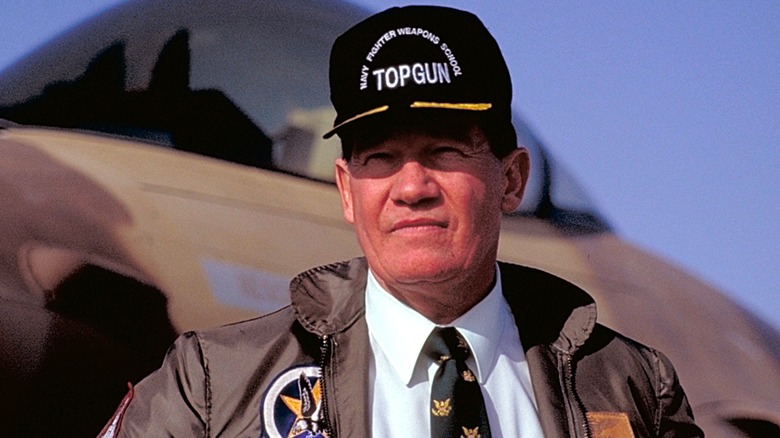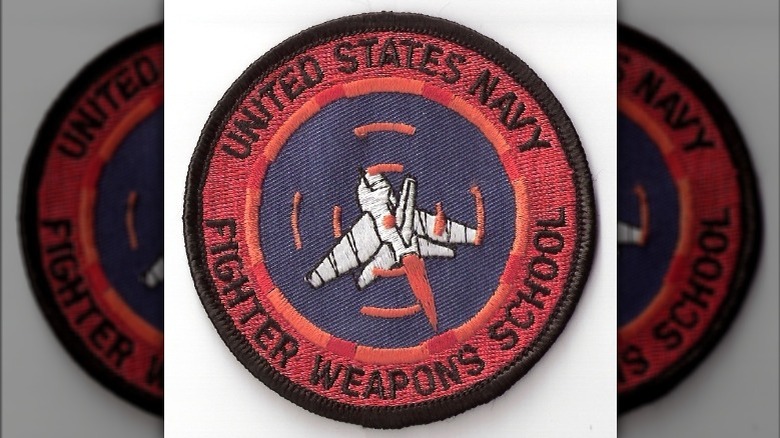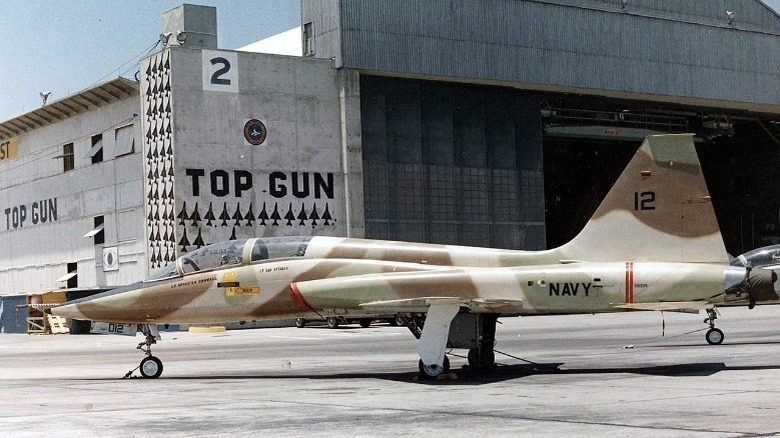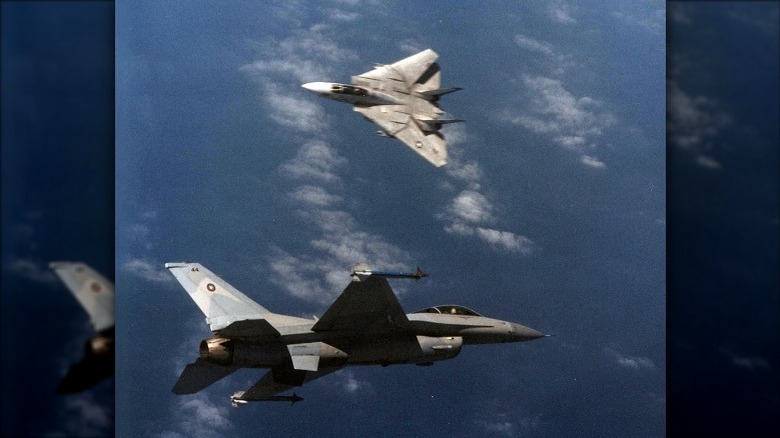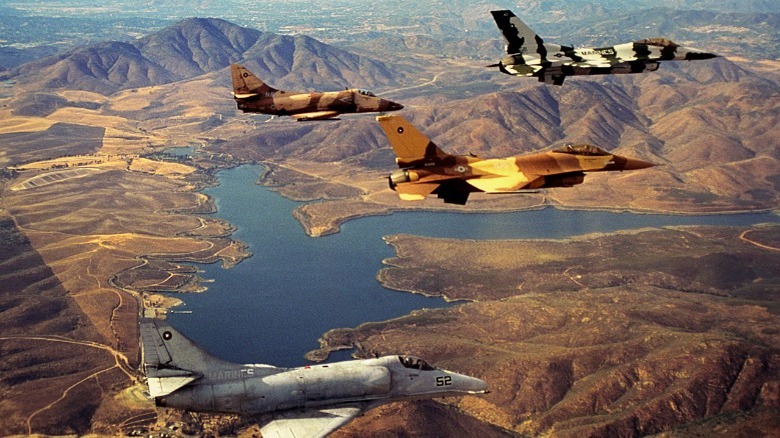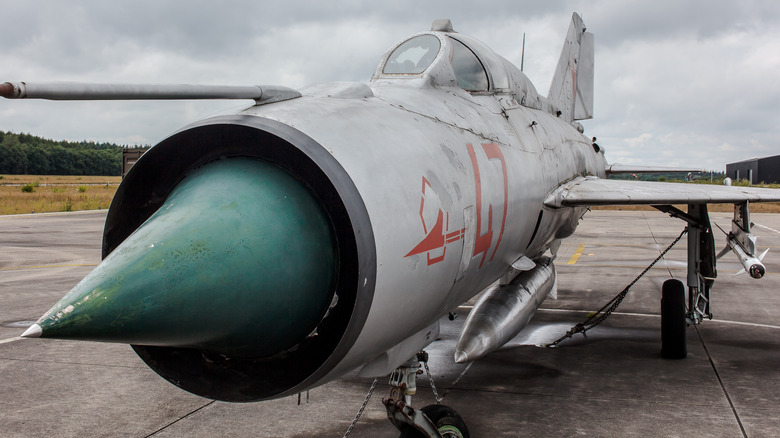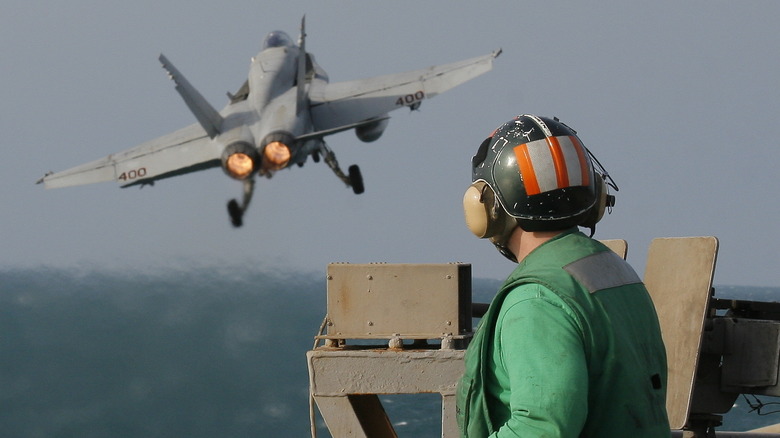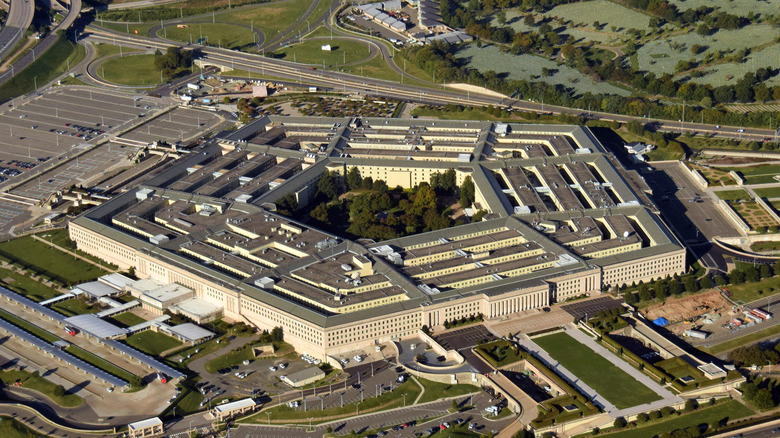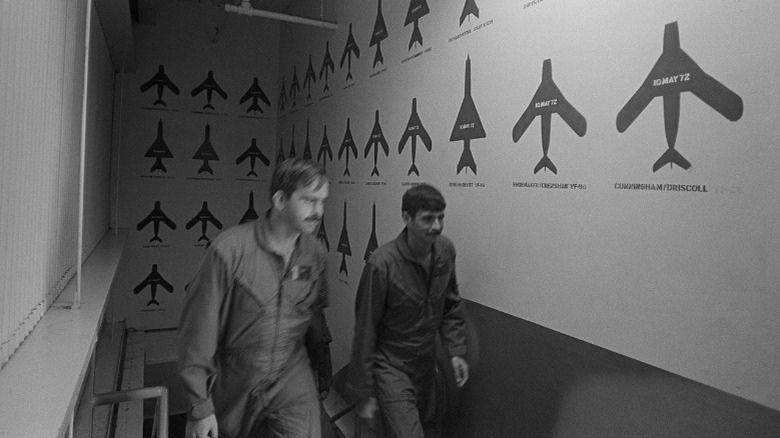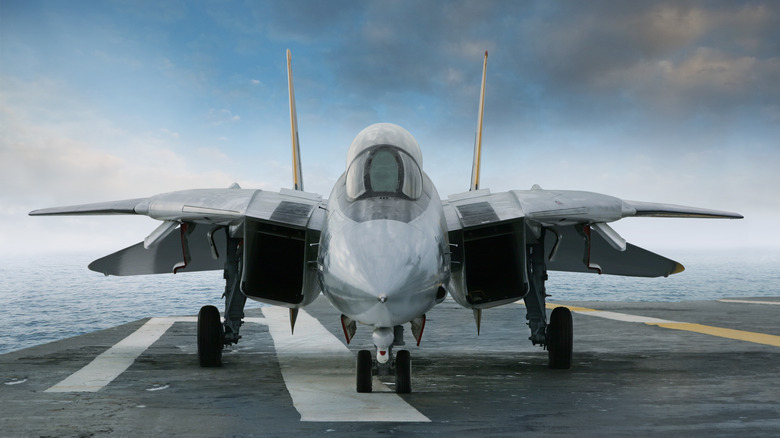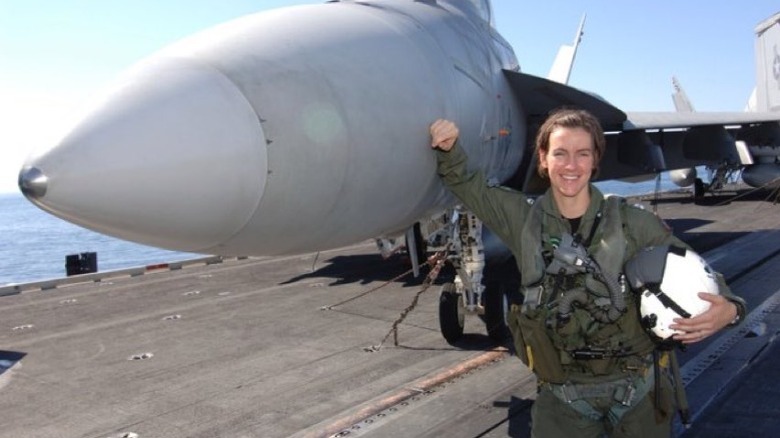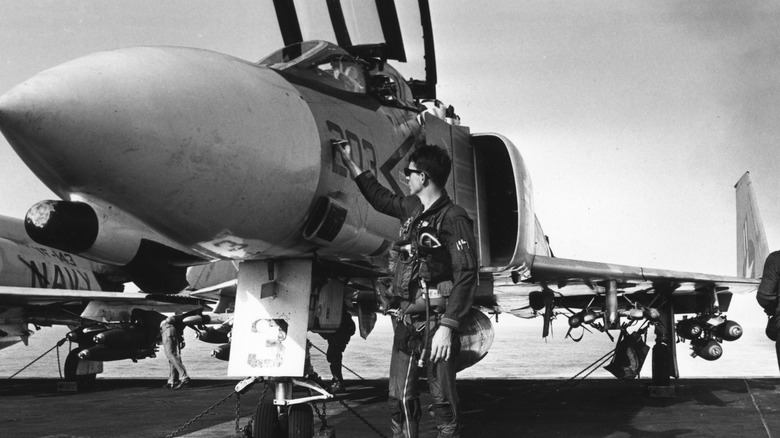The Untold Truth Of The Real TOPGUN
"Top Gun: Maverick" hit movie screens in 2022. The $150 million film, per Screen Rant, with Tom Cruise reprising his role as Captain Pete "Maverick" Mitchell, came out after a long delay caused by the COVID-19 pandemic. But the year or so its release was bumped — largely because the film's star opposed a streaming release, per Radio Times — hasn't dampened enthusiasm for the picture; audiences had grown impatient waiting for its premiere, given that this sequel hit theaters more than 25 years after the first "Top Gun" came out back in 1986.
That 35-year span is significantly longer than it took for the first movie to be shot following the formation of the real TOPGUN program, which the Navy created during the height of the Vietnam War. The point of the real TOPGUN program is to make good fighter pilots into great fighter pilots. And it does that not with a lot of macho competition as depicted on the screen, but with close communication and collaboration among pilots, endless hours of study, and plenty of decidedly bada** flying.
This is the untold truth of the real TOPGUN.
The actual name was the United States Navy Fighter Weapons School
When it was first formed, the program often referred to as TOPGUN was officially named the United States Navy Fighter Weapons School, according to the USN. The name TOPGUN would be effectively — but not technically — adopted by the Navy in later years and is even used in official military literature by and about the Navy, but the program itself was about education and training, not competition and showiness, as the name TOPGUN and the public reputation of the program imply.
In fact, the Navy states that pilots in the school "describe themselves using three words — humble, credible, approachable." That may well be downplaying a bit of the ego that pops up in some of the TOPGUN fliers, but it at least speaks to the intent of the program, which is to create the best flight instructors on the planet, not to create pilots with outsized senses of self.
What was humble indeed was the first facility used for the TOPGUN program. According to the Defense Department, the elite school was "initially based out of a trailer in the parking lot" of an airbase. But this was not because of a lack of respect for the new program, but rather out of a desire for expediency: the sooner pilots could get superior training, the sooner the war in Vietnam could turn around.
The program has been around for more than 50 years
As noted, the fighter pilot training program known as TOPGUN wasn't even 20 years old when the Hollywood movie that would make it famous worldwide came out. The United States Navy Fighter Weapons School was established in 1969, according to Live Science. This was the year that would end up being the height of America's involvement in the Vietnam War, and — as will be discussed momentarily — the TOPGUN program was created as a direct result of the experience of Navy pilots flying in combat over Southeast Asia. Or, to be more precise, based on the lack of experience these pilots were displaying.
Now more than half a century old, the school is still going strong, even though some of the tactics originally taught there have changed, not because they were bad originally, but because over the decades pilots had to adapt as technology improved and the nature of aerial combat — and ground attack, in particular — has evolved since the late 1960s.
It was created because pilots had lost critical fighting skills
The TOPGUN program was created to teach pilots dogfighting skills they had lost due to a reliance on technology — or at least that was the primary finding of a 1968 Navy-commissioned study called the "Report of the Air-to-Air Missile System Capability Review." More commonly called the Ault Report for its lead author, Navy Captain Frank Ault, the study was initiated in the wake of higher than expected combat losses among American pilots fighting in the skies over Vietnam. It determined, among other things, that American pilots had become too reliant on technology.
The specific performance deficiencies the Ault Report identified were causing pilots to be less effective fighters and more vulnerable to the enemy, with the two major problems being often faulty air-to-air missiles — something the weapons' manufacturers would need to address — and a lack of the dogfighting skills that American fliers had honed in WWII and the Korean War, which was on the Navy to confront. In one telling line from the report's opening pages, the authors wrote: "The review indicates that numerous design, procedural, and organizational changes can and should be made."
The most effective change would be the intensive new pilot training of the United States Navy Fighter Weapons School, or TOPGUN.
The TOPGUN school is based out of the Nevada desert
Navy pilots operate primarily via aircraft carriers, which are of course found on the ocean. But the TOPGUN school is set up in an area that's the polar opposite of the open seas: the desert. Specifically, the Navy's TOPGUN school is currently found in the high desert near Fallon, Nevada, according to the Navy's own site. The area is perfectly suited to advanced aviation training because much of the land is broad and flat, the air in northern Nevada tends to be crisp and clear, and also because there is not exactly a lot of population density in the region.
This is good, because frequent supersonic flights cause lots of pesky sonic booms. Also, it's best not to have lots of eyes on the aircraft and tactics at the forefront of American military aviation. The original location for the TOPGUN school was first established, it was located in Miramar, California, according to the San Diego Air & Space Museum. That placed it considerably closer to a lot of people, but the program was moved in 1996 and the military facility in Miramar was turned over to the Marine Corp.
Early TOPGUN instructors sometimes flew captured Soviet jets
Creating the best possible verisimilitude of real air-to-air combat for their training has always been of the utmost importance for the instructors at the TOPGUN program. Thus they would (and continue to) fly all sorts of different aircraft when squaring off against the trainee pilots in the school. In the 20th century, this often included the flying of captured Soviet aircraft, according to Live Science. By "fighting" against the actual aircraft they would see in the skies in actual combat, American pilots gained an edge their adversaries could never hope to enjoy.
And in using the captured enemy planes in the course of TOPGUN and in other testing, the military learned about the strengths and weaknesses of those aircraft in general. Much of the testing of Soviet aircraft also took place at the ironically famed yet secretive Area 51, according to The Guardian.
After the USSR fell, the name and the focus of TOPGUN changed
When the Navy established the TOPGUN program, it was geared toward improving American pilots' skills in air-to-air combat, a.k.a. dogfighting. The training was sensible at the time, as pilots were not faring as well as expected in combat against North Vietnamese pilots flying Soviet planes. (And most likely, many American pilots also faced Russian and Chinese pilots, though that was never officially admitted by either communist nation.) In the years after the Vietnam War, the focus on air-to-air combat tactics and training remained in place as active combat against the USSR or its proxies was still very much a threat.
But then, in the early 1990s, the Union of Soviet Socialist Republics collapsed. Without the Soviet Union and its air force to worry about, soon the way America used its air power was being reimagined. Thus, in the mid-1990s, the Navy changed the official name of the school to the Strike Fighter Tactics Instructor program and began to include more ground attack training, per Live Science. Of course, despite the official name change and new location, everyone still calls it TOPGUN.
TOPGUN is not an acronym and does not stand for anything in particular
If you know a thing or two about the American Department of Defense, or D.O.D., you'll know it's an organization that, writ large, loves its acronyms. There's the JCO, the MRE, the LZ, the SECDEF, the SNAFU and on it goes, according to Military.com. So it's entirely reasonable to assume that TOPGUN is military shorthand for something like Training of Primary Gunnery Units, Navy, or some such term. But, in fact, it actually means ... nothing.
TOPGUN is not an acronym and does not stand for anything in particular, per the D.O.D.'s own information. Calling the program TOPGUN started off basically as a joke and stuck because, well, it's a lot easier to say "TOPGUN" than it is to say "United States Navy Fighter Weapons School" or "Strike Fighter Tactics Instructor" program. That said, in spirit, TOPGUN really is a suitable name for the program, as it produces the top "guns," or fighter pilots, the Navy has to offer, and because it sources as its students those pilots who are already near the top of the game.
More than 90% of pilots who attend TOPGUN pass
Getting selected to go to the TOPGUN program in the first place? That's difficult, and only a small number of Naval aviators will ever be tapped for that honor. As for passing the training successfully and becoming a graduate of the program, according to the D.O.D., the chances there are sky-high. Between 90% and 95% of the pilots who enter TOPGUN training will pass. In the words of one officer, Navy Commander Dustin Peverill: "The staff's job is to graduate students, not to attrite them." And remember that those selected for the intensive training — who are expected to go on to be trainers themselves — are already noted as superb fliers, so it's really not all that surprising.
Now, as for being an instructor in the program? That's truly rare stuff. In fact, according to the Defense Department, fewer than 5% of Navy pilots will get a chance to teach there.
Multiple planes have been used at TOPGUN through the years
Pilots going through the TOPGUN program will always fly the planes that are currently in service with the Navy. In the 1986 movie "Top Gun," they were flying the F-14 Tomcat, then the primary fighter jet used by the USN. Today, students fly the F/A-18 Super Hornet and F-35 Lightning, those being the current best fighter jets suitable for Naval operation. They are at the current leading edge of a long line of fighters used in TOPGUN training.
Before the F-14, per the D.O.D., the fliers in the program primarily used the F-4 Phantom, arguably America's premier fighter jet throughout the later 1960s and to the mid-1970s. But while these four planes, the F-4, F-14, F/A-18 (the Super Hornet has that designation because it is used for both aerial fighting and ground attack. And "maritime strike"), and the F-35 are the planes used by trainees, the instructors have climbed into all sorts of other aircraft as they faced off.
Many captured Soviet planes were used in training at one point (when the USSR was still a thing), but among other American jets used in TOPGUN training have been the vaunted F-86, the A-4, A-6, and A-7, the nimble F-5, and the once record-setting F-8. Today, instructors in the TOPGUN school often fly the F-16, which is primarily an Air Force plane, as it is more agile than the larger F/A-18 and F-35, thus enhancing the challenge.
Several women have successfully completed the program
In movies like "Top Gun" and "Top Gun: Maverick," we tend to see the TOPGUN program as primarily a boys' club, Kelly McGillis' turn as an instructor pilot named Charlotte "Charlie" Blackwood in the original film being the one notable exception. And indeed for much of its tenure, the TOPGUN program was dominated by male pilots. But several women have gone through the school, and have come out with flying colors, if you'll permit an excellent pun.
One notable female TOPGUN graduate, the program's first woman, per the Navy, was Cmdr. Becky Calder, who graduated from the United States Naval Academy in 1998, went on to fly F/A-18 jets, and then was selected for the Strike Fighter Tactics Instructor program. She would also serve in several combat zones. More recently, per the Defense Department, Navy Lt. Nikkol Rajkovacz completed the TOPGUN course, and then, in 2021, she became a TOPGUN staff member herself.
The TOPGUN program has been remarkably effective
Even more impressive than the aerial stunts seen in a movie like "Top Gun" or "Top Gun: Maverick" or, for that matter, the actual flying done as part of the real TOPGUN school is the real performance of the pilots who went through the program and then went into combat. America has not been involved in a meaningful air combat war in generations, so you have to look back to the Vietnam War, the impetus for the creation of the school in the first place, for actionable data.
In the middle and later years of the 1960s, prior to the Ault Report and TOPGUN training, Naval fighter pilots over Vietnam were experiencing an approximate 1:4 casualty ratio against enemy pilots, meaning for every four planes an American downed, one American was shot from the sky; after the implementation of TOPGUN training, according to the U.S. Navy, the figures improved threefold. With Navy pilots trained in the United States Navy Fighter Weapons School and then those further trained by them in the fight, the casualty rate changed to 1:12, meaning Americans were scoring 12 times more aerial victories than the enemy.
Again, we have not had the opportunity to see how the numbers would hold up (or be surpassed) today, but given that American military technology has only steadily improved, training has never flagged, and given that the same can't be said for the country's potential adversaries, it's entirely plausible that in a future war with American Navy pilots seeing air-to-air combat, Americans would be dominant.
The 1986 movie led a huge bump in Naval recruitment
When the movie "Top Gun" came out in 1986, a lot of people were moved by the picture. And according to LAist reporting, many were so moved that they decided to join the Navy. Seeing the tide of enthusiasm growing, if you'll permit an aquatic pun here, the Navy sprung into action, with Navy recruiters even setting up booths outside theaters that scored a huge number of enlistments as people signed up right after walking out of "Top Gun."
While combat and geopolitical relations are totally different now, it's possible that 2022's "Top Gun: Maverick" could have similar results to its predecessor more than 35 years ago. The world is a very different place, what with the Soviet Union long since collapsed and gone and, as noted, America having gone some two generations without an air war (Vietnam was only a bit over a decade in the rearview in 1986, remember). That said, given the once seemingly-impossible events of 2022, with Russia's invasion of Ukraine in the headlines and on minds everywhere as they go see the film, perhaps the connections to the past are not so tenuous.
Per LAist, the Pentagon (the D.O.D. itself, e.g.) is very much hoping that "Top Gun: Maverick" will drive the same kind of enthusiasm for the Navy as Maverick, Goose, and the rest of the gang did back in the 1980s.
